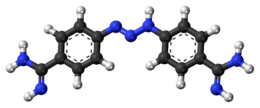 | |
 | |
| Clinical data | |
|---|---|
| Trade names | Azidin, Berenil, Ganasag, Pirocide |
| Other names | 4,4'-(1-Triazene-1,3-diyl)bis(benzenecarboximidamide) |
| Routes of administration | IM, SC |
| ATCvet code | |
| Legal status | |
| Legal status |
|
| Identifiers | |
| |
| CAS Number | |
| PubChem CID | |
| ChemSpider | |
| UNII | |
| ChEBI | |
| ChEMBL | |
| CompTox Dashboard (EPA) | |
| ECHA InfoCard | 100.007.860 |
| Chemical and physical data | |
| Formula | C14H15N7 |
| Molar mass | 281.323 g·mol−1 |
| 3D model (JSmol) | |
| |
| |
Diminazene (INN; also known as diminazen) is an anti-infective medication for animals that is sold under a variety of brand names. It is effective against certain protozoa such as Babesia, Trypanosoma, and Cytauxzoon. The drug may also be effective against certain bacteria including Brucella and Streptococcus.[1][2]
Chemically it is a di-amidine and it is formulated as its aceturate salt, diminazene aceturate.
The mechanism is not well understood; it probably inhibits DNA replication,[1] but also has affinity to RNA.
- ^ a b Peregrine AS, Mamman M (September 1993). "Pharmacology of diminazene: a review". Acta Tropica. 54 (3–4): 185–203. doi:10.1016/0001-706X(93)90092-P. PMID 7902657.
- ^ Mungube EO, Vitouley HS, Allegye-Cudjoe E, Diall O, Boucoum Z, Diarra B, et al. (August 2012). "Detection of multiple drug-resistant Trypanosoma congolense populations in village cattle of south-east Mali". Parasites & Vectors. 5: 155. doi:10.1186/1756-3305-5-155. PMC 3432589. PMID 22852796.